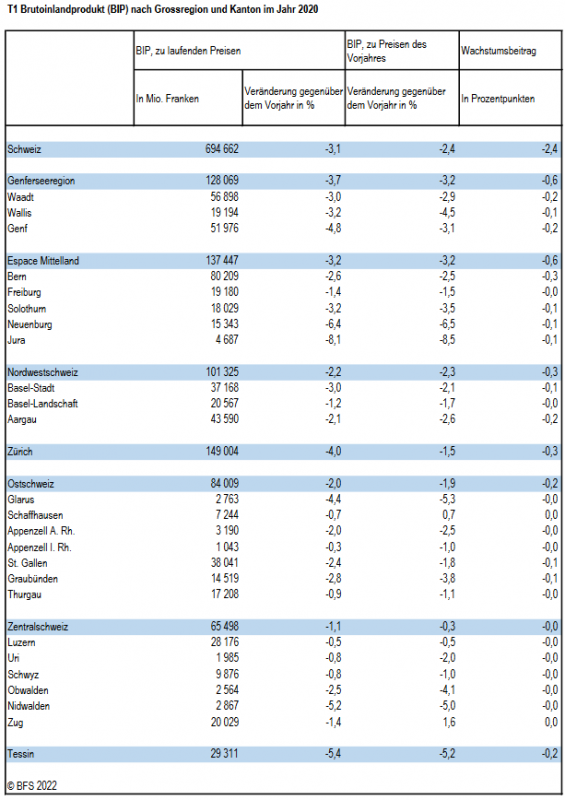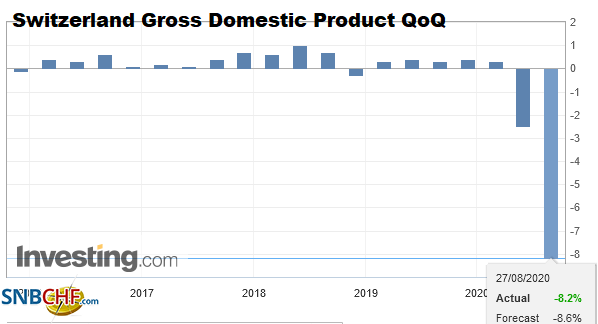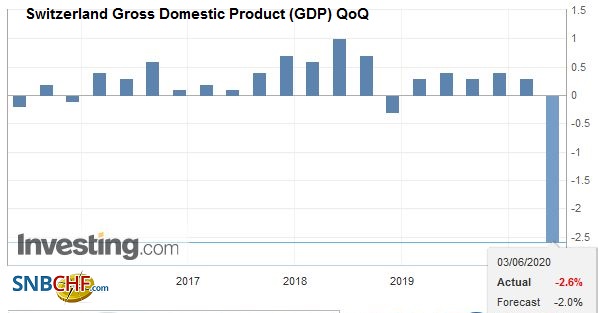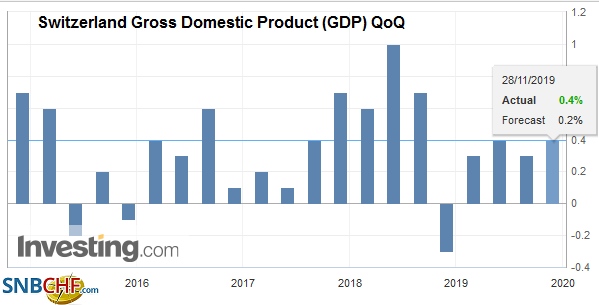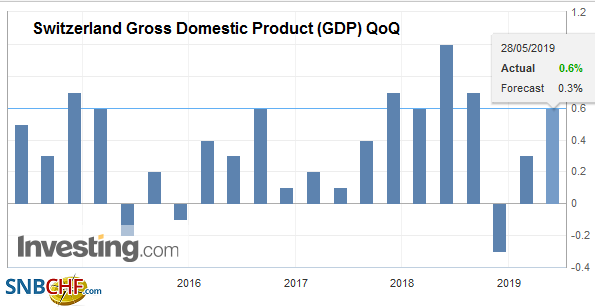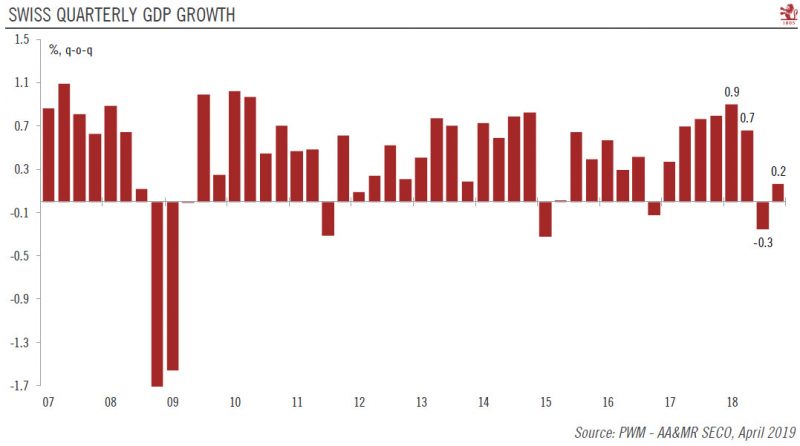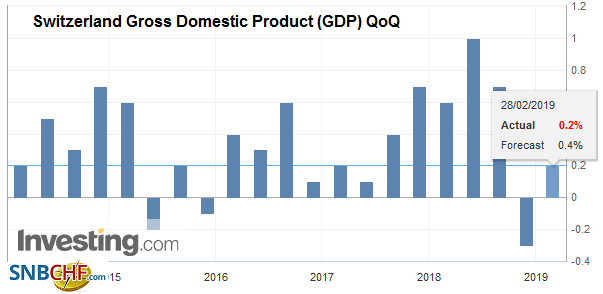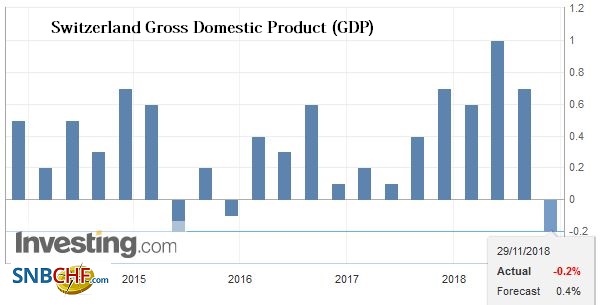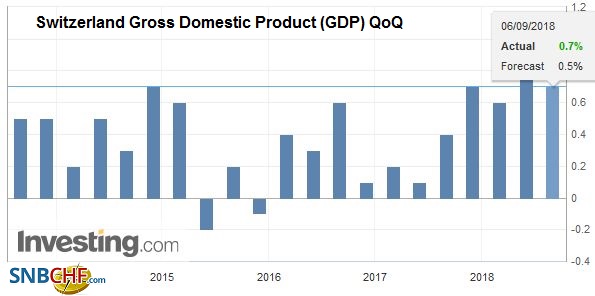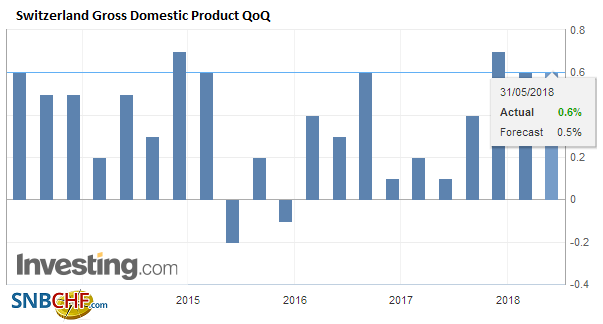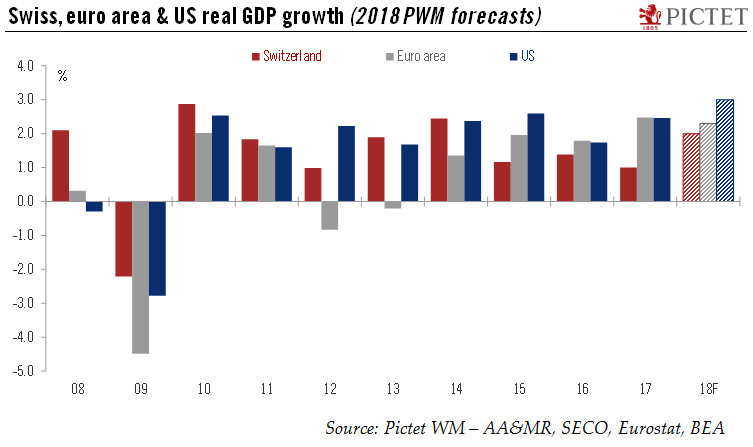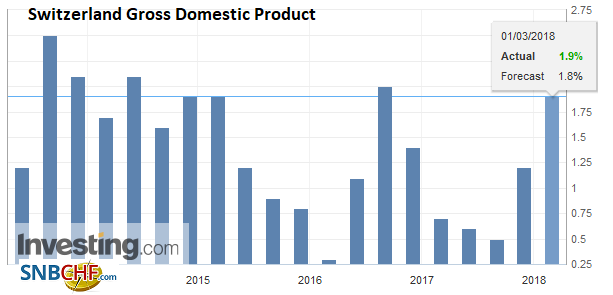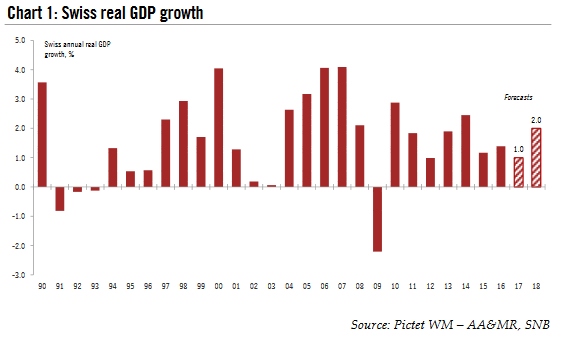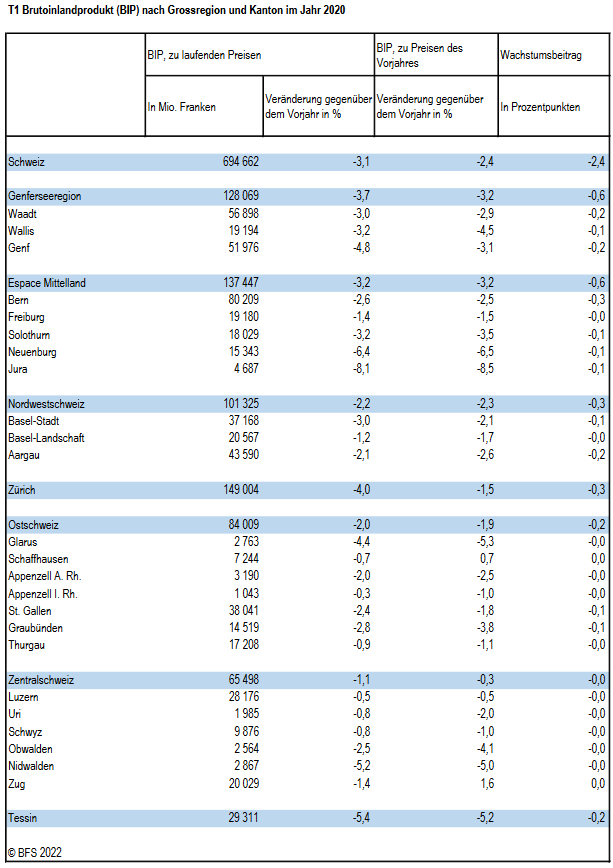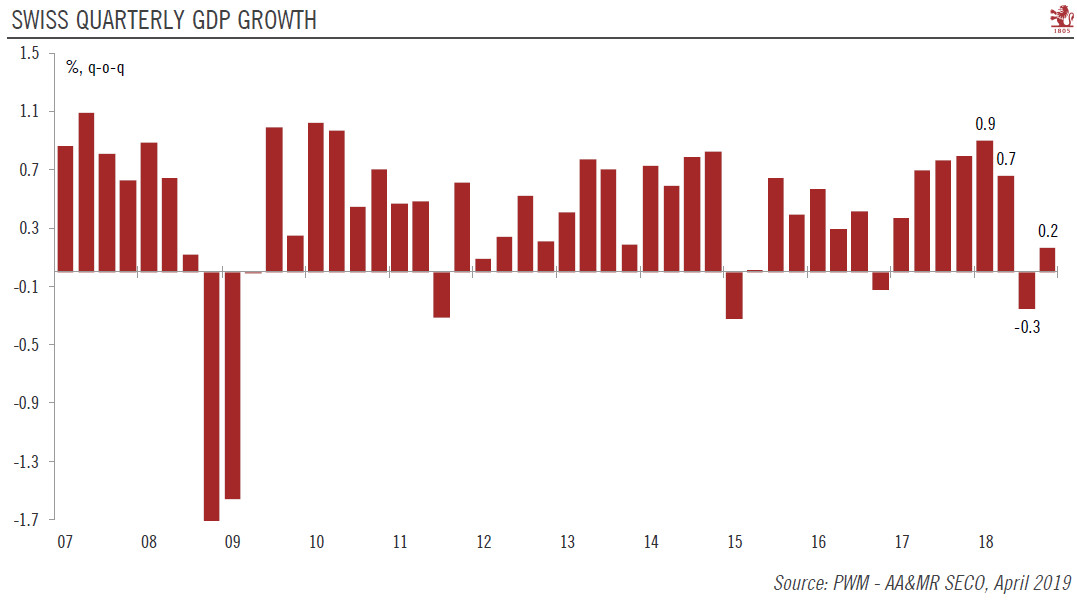Tag Archive: Switzerland Gross Domestic Product
Gross Domestic Product (GDP) measures the annualized change in the inflation-adjusted value of all goods and services produced by the economy. It is the broadest measure of economic activity and the primary indicator of the economy’s health. A stronger than expected number should be taken as positive for the EUR and a lower than expected number as negative to the EUR.
Switzerland Gross domestic product fell in almost all cantons in 2020
2020 was marked by the COVID-19 pandemic, which affected the entire regional economic fabric in Switzerland. National growth in gross domestic product (GDP) fell to –2.4% at the previous year's prices and almost all cantons recorded a decline in activity. Jura was the most affected (–8.5%), followed by Neuchâtel (–6.5%), Glarus (–5.3%) and Ticino (–5.2%).
Read More »
Read More »
FX Daily, June 01: CNY Softens after PBOC’s Move; Equities Advance on Stronger World Outlook
The US dollar fell against most major currencies following the PBOC's modest move to reduce the upward pressure on the yuan. Follow-through selling was seen earlier today, and sterling reached a new three-year high. However, the dollar found a bid in the European morning, while the Scandi currencies held on to most of their earlier gains.
Read More »
Read More »
Switzerland GDP Q4 2020: +0.3 percent QoQ, -1.6 percent YoY
Switzerland’s GDP growth slowed to 0.3 % in the 4th quarter after reaching 7.6 % in the 3rd quarter. Major losses were recorded in the services directly affected by the tightening of the containment measures. Other industries continued to recover. On the whole, the second wave of the coronavirus until the end of 2020 had much less of an impact on the economy than the first wave did last spring.
Read More »
Read More »
Switzerland GDP Q2 2020: -8.2 percent QoQ, -9.3 percent YoY
Switzerland’s GDP fell by –8.2 % in the 2nd quarter of 2020, after decreasing by –2.5 % (revised) in the previous quarter.* Domestic economic activity was severely restricted in the wake of the pandemic and the measures are taken to contain it. The global economy also plunged into a sharp recession. However, Switzerland’s GDP decline remained limited in an international comparison.
Read More »
Read More »
Switzerland GDP Q1 2020: -2.6 percent QoQ, -1.3 percent YoY
Switzerland’s GDP fell by –2.6 % in the 1st quarter of 2020, after rising by +0.3% in the previous quarter. Due to the coronavirus pandemic and the measures to contain it, economic activity in March was severely restricted. The international economic slump also slowed down exports.
Read More »
Read More »
Switzerland GDP Q3 2019: +0.4 percent QoQ, +1.1 percent YoY
Switzerland’s GDP rose by 0.4% in the 3rd quarter of 2019, after increasing by 0.3% in the previous quarter. Exports of chemical and pharmaceutical products and energy were key contributing factors. In other areas, the impact of the subdued international environment was felt more strongly. The economic slowdown is being borne out on the whole.
Read More »
Read More »
Switzerland GDP Q2 2019: +0.3 percent QoQ, -0.2 percent YoY
Switzerland’s GDP rose by 0.3% in the 2nd quarter of 2019, after increasing by 0.4% (revised) in the previous quarter.1 The development of domestic and foreign demand was weak, as in other European countries, which had a particularly negative impact on the service sectors.
Read More »
Read More »
Switzerland GDP Q1 2019: +0.6 percent QoQ, +1.7 percent YoY
Switzerland’s GDP rose by 0.6% in the 1st quarter of 2019. Growth was driven primarily by increasing domestic demand. Foreign trade also provided positive impetus. Value added grew in most sectors.
Read More »
Read More »
Switzerland: Lower growth, lower inflation
Growth and price rises should moderate in 2019.The Swiss economy posted impressive GDP growth in 2018, although there was significant divergence between strong growth in the first half and stagnation in the second. Overall, we expect Swiss GDP to expand by 1.3% in 2019, down substantially from 2.5% in 2018. Risks to our growth outlook for Switzerland are tilted to the downside.
Read More »
Read More »
Switzerland GDP Q4 2018: +0.2 percent QoQ, +1.4 percent YoY
Switzerland’s GDP rose by 0.2% in the fourth quarter of 2018. Manufacturing saw dynamic growth. Concurrently, exports of goods increased significantly. In contrast, domestic demand stagnated. GDP growth was 2.5% for 2018 as a whole.
Read More »
Read More »
Switzerland GDP Q3 2018: -0.2 percent QoQ, +2.4 percent YoY
Switzerland's GDP fell by 0.2% in the 3rd quarter of 2018 due to both the industrial and service sectors. On the expenditure side, domestic demand and foreign trade had a negative impact. Switzerland’s GDP fell by 0.2% in the 3rd quarter of 2018, after climbing by 0.7% in the previous quarter.
Read More »
Read More »
Study finds Swiss economy is looking up, but risks abound
Switzerland's GDP is on track this year to increase by 2.9%, according to a forecast by Zurich's KOF Swiss Economic Institutepublished Wednesday. This positive outlook is tempered by concerns over the potentially negative impact of global trade wars and a no-deal Brexit on the neutral nation.
Read More »
Read More »
Switzerland GDP Q2 2018: +0.7 percent QoQ, +3.4 percent YoY
The Swiss economy once again recorded dynamic growth in the 2nd quarter of 2018. GDP (+0.7%) expanded at an above-average rate for the fifth quarter in a row. This ex-pansion was largely supported by manufacturing, which has been experiencing a re-markable upturn since spring of 2017. Exports of goods increased accordingly.
Read More »
Read More »
Switzerland GDP Q1 2018: +0.6 percent QoQ, +2.2 percent YoY
Switzerland’s real gross domestic product (GDP) grew by an above-average 0.6% in the 4th quarter of 2017.1 Growth was broad-based across the various business sectors, with manufacturing, construction and most service sectors, particularly financial services, providing momentum. On the expenditure side, growth was underpinned by consumption and investment in construction but was hindered by investment in equipment and foreign trade.
Read More »
Read More »
Switzerland: So far so good
According to the State Secretariat for Economic Affairs (SECO)’s quarterly estimates, Swiss real GDP rose by 0.6% q-o-q in Q4 (2.4% q-o-q annualised; 1.9% y-o-y), above consensus expectations (0.5%). The Swiss economy expanded by 1.0% in 2017 overall, in line with our own forecast. This comes after GDP growth of 1.4% in 2016 and 1.2% in 2015.
Read More »
Read More »
Switzerland GDP Q4 2017: +0.6 percent QoQ, +1.9 percent YoY
Switzerland’s real gross domestic product (GDP) grew by an above-average 0.6% in the 4th quarter of 2017.1 Growth was broad-based across the various business sectors, with manufacturing, construction and most service sectors, particularly financial services, providing momentum. On the expenditure side, growth was underpinned by consumption and investment in construction but was hindered by investment in equipment and foreign trade.
Read More »
Read More »
Swiss fact: nearly 50 percent of Swiss GDP comes from 4 cantons
Switzerland is made up of 26 cantons – technically six are half cantons1 – each with its own distinct taxes, education system, hospitals and government. Land area varies significantly, from 37 sq/km Basel-Stadt to 7,105 sq/km Graubünden.
Read More »
Read More »
The Swiss economy is gaining momentum
Swiss growth was disappointing at the end of 2016 and in the first half of 2017. Consequently, GDP growth this year is likely to be just 1.0% , its lowest level since 2012 . However, a wide set of statistics are already painting a considerably more positive picture of strengthening growth as we approach the end of 2017. Of particular note is the increasing contribution of manufacturing to real GDP growth.
Read More »
Read More »
Switzerland GDP Q3 2017: +1.2 percent QoQ, +1.2 percent YoY
Switzerland’s real gross domestic product (GDP) grew by 0.6 % in the 3rd quarter of 2017,* boosted by manufacturing in particular. Many service sectors also contributed to growth, including trade, business services and healthcare. By contrast, value added fell slightly in construction and the financial sector.
Read More »
Read More »
Switzerland GDP Q2 2017: +0.3 percent QoQ, +0.3 percent YoY
Switzerland's real gross domestic product (GDP) grew by 0.3 % in the 2nd quarter of 2017. Manufacturing, the financial sector and the hotel and catering in-dustry significantly boosted growth, while developments in trade, public administration and the healthcare sector were sluggish. On the expenditure side, growth was driven by domestic demand, with positive momentum coming from both consumption and investment.
Read More »
Read More »









